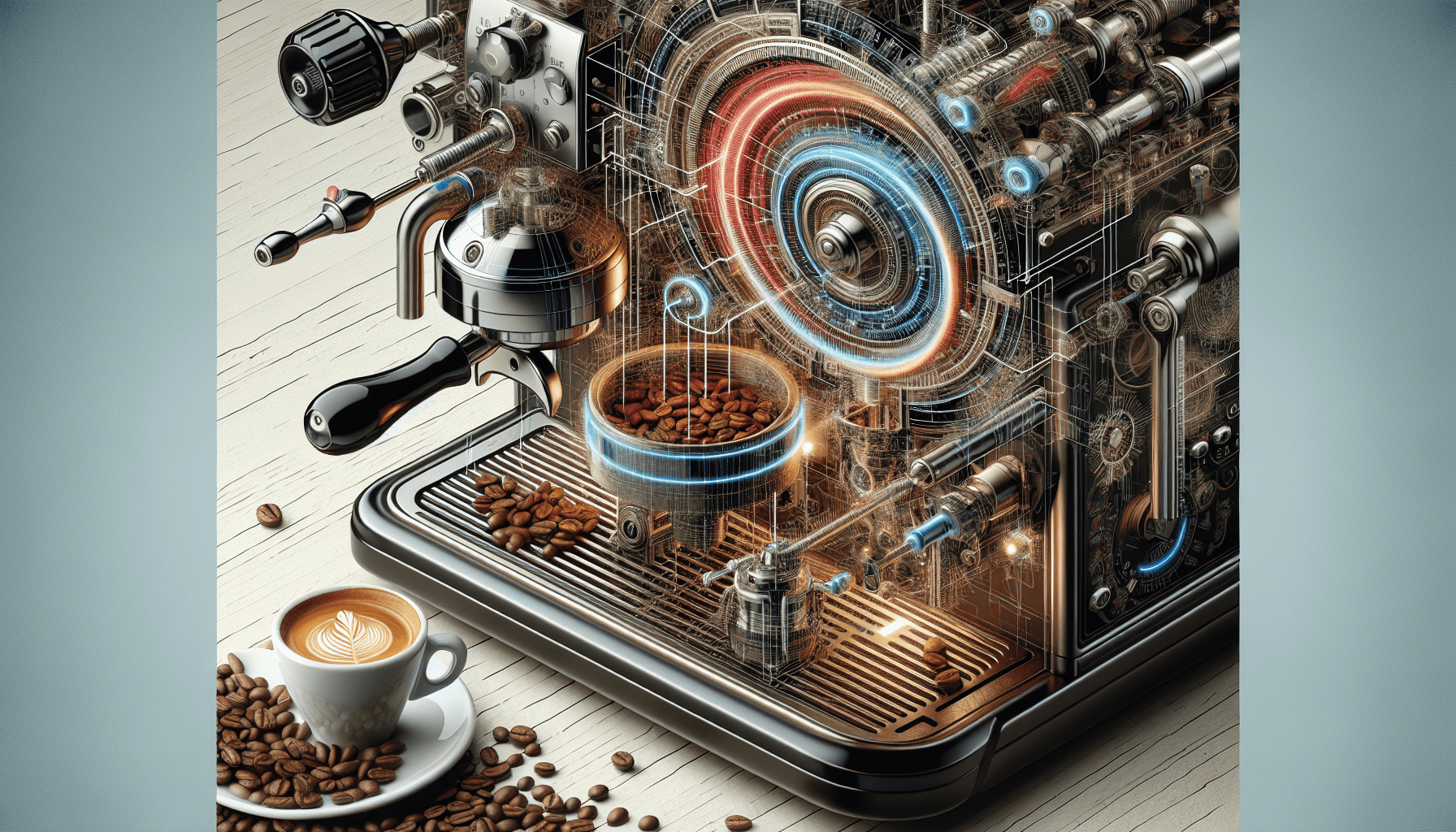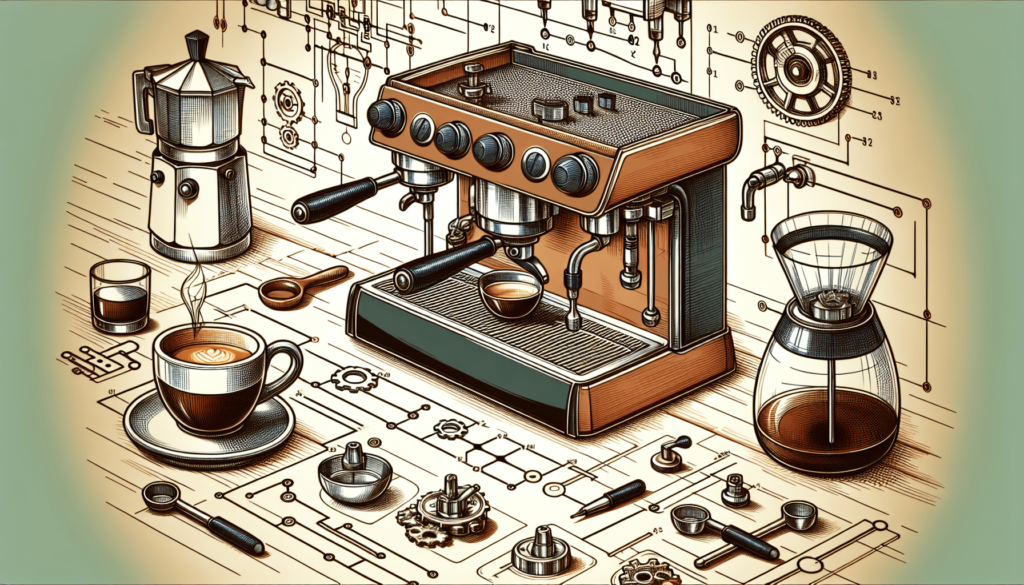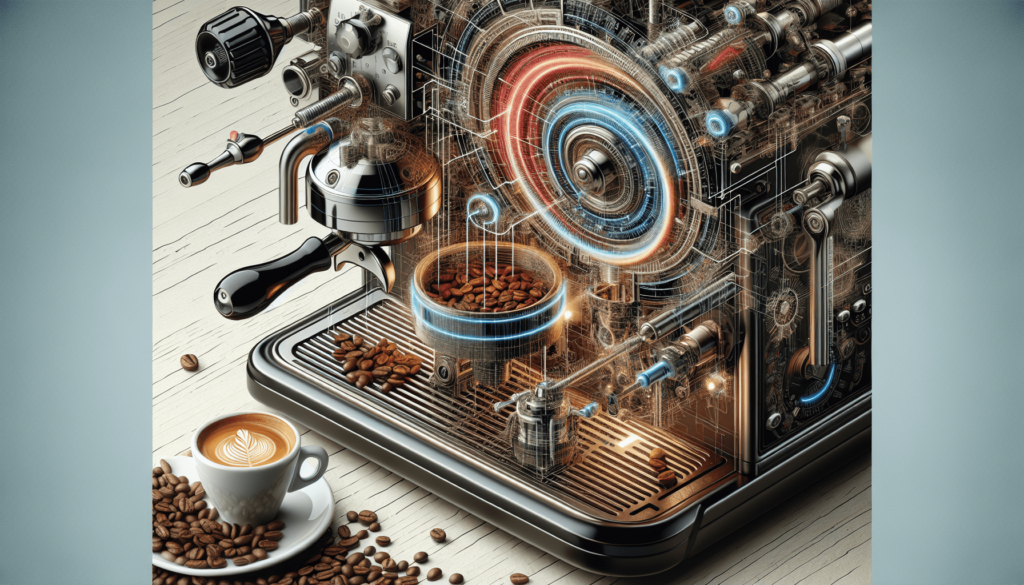
In the world of coffee, the impact of espresso machines on the flavor of our favorite brew often goes unnoticed. However, it is the design of these machines that plays a crucial role in shaping the taste profile of our morning cup of joe. From the temperature of the water to the pressure exerted during the brewing process, every aspect of the espresso machine design contributes to the final flavor experience. In this article, we will explore the fascinating relationship between espresso machine design and coffee flavor, shedding light on the hidden factors that make each cup of espresso truly unique.

1. Importance of Espresso Machine Design
Espresso machine design plays a crucial role in enhancing the coffee brewing process. By carefully considering the various components and features of the machine, manufacturers can create a device that not only produces a great tasting espresso but also offers the necessary control over temperature and pressure for optimal extraction efficiency.
1.1 Enhancing the Coffee Brewing Process
The design of an espresso machine directly impacts the quality of the brewed coffee. From the moment the beans are ground to the final extraction, every aspect of the machine’s design can influence the flavor profile of the espresso. By incorporating features like precise temperature control, pressure regulation, and even water dispersion, manufacturers can enhance the brewing process to achieve the desired taste and aroma.
1.2 Controlling Temperature and Pressure
Temperature and pressure are two critical variables that must be carefully controlled during the espresso brewing process. The design of the espresso machine determines how effectively these variables can be managed. By utilizing innovative boiler systems, heat exchangers, and pressure control mechanisms, manufacturers can create machines that maintain the ideal temperature and pressure throughout the brewing process, resulting in a consistent and flavorful cup of espresso.
1.3 Extraction Efficiency
The efficiency of extraction, the process by which water extracts the soluble compounds from coffee grounds, is heavily influenced by the design of the espresso machine. Factors such as boiler type and capacity, the design of the portafilter and grouphead, and even the size and shape of the water dispersion screen can all impact the extraction process. A well-designed espresso machine optimizes these factors to ensure maximum extraction efficiency, yielding a more balanced and flavorful espresso.
2. Components and Features Affecting Flavor
To understand how espresso machine design impacts coffee flavor, it is essential to evaluate the various components and features that can significantly influence the taste of the final brew.
2.1 Boiler Type and Capacity
The type and capacity of the boiler in an espresso machine play a crucial role in maintaining stable brewing temperature. Single-boiler machines are common in entry-level espresso machines and typically require time to switch between brewing and steaming temperature. On the other hand, dual-boiler systems allow for simultaneous brewing and steaming, ensuring consistent temperature control and minimizing waiting time. The boiler capacity also affects the overall performance of the machine, as it determines how quickly the machine can recover heat between shots.
2.2 Heat Exchanger or Dual Boiler Systems
Heat exchanger and dual boiler systems offer significant advantages in terms of temperature stability during the brewing process. Heat exchangers use a single boiler to heat both the brewing water and the steam supply, eliminating the need for temperature adjustments during brewing. Dual boiler systems, as mentioned earlier, have separate boilers for the brewing water and steam, allowing for more precise temperature control. These systems ensure that the water used to extract the coffee grounds remains at the optimal brewing temperature, contributing to a better-tasting espresso.
2.3 Pump and Pressure Control
The pump and pressure control mechanisms of an espresso machine greatly impact the extraction process. The pump is responsible for generating the pressure necessary to force water through the coffee grounds and extract the flavor compounds. An espresso machine with consistent and accurate pressure control ensures a uniform extraction, resulting in a well-balanced espresso with enhanced flavors.
2.4 Portafilter Design
The portafilter, the tool that holds the coffee grounds during brewing, also plays a vital role in the flavor extraction. A well-designed portafilter allows for even distribution of water over the coffee grounds, ensuring optimal extraction. Features such as a stable handle and a precision-fit basket contribute to a more controlled brewing process and ultimately a more delicious cup of espresso.
2.5 Grouphead and Brew Pressure
The grouphead, the component that connects the portafilter to the machine, assists in maintaining stable brew pressure. The design of the grouphead affects both the temperature stability and water flow during the extraction process. A well-designed grouphead ensures uniform heating and effective water distribution over the coffee grounds, resulting in a more consistent and flavorful shot of espresso.
2.6 Size and Shape of the Water Dispersion Screen
The water dispersion screen, located within the grouphead, influences how water is distributed over the coffee grounds during extraction. The size and shape of the dispersion screen play a crucial role in determining the rate of water flow and the evenness of water distribution. A properly designed water dispersion screen promotes a more thorough extraction, ensuring that the flavors are extracted evenly from the coffee grounds.
3. Impact of Temperature Control
Temperature control is one of the fundamental aspects of espresso brewing. The ability to precisely control the temperature at various stages of the brewing process can significantly affect flavor extraction.
3.1 Pre-Infusion Temperature
Pre-infusion, the initial stage of the brewing process, involves wetting the coffee grounds with hot water before applying full brewing pressure. The pre-infusion temperature sets the stage for the extraction process, allowing the coffee grounds to bloom and release flavors. With proper temperature control, manufacturers can ensure that the pre-infusion temperature is optimized to enhance aroma, acidity, and sweetness.
3.2 Brewing Temperature
The brewing temperature is a critical factor in determining the flavor profile of the espresso. Different coffee beans require specific temperature ranges for optimal extraction. An espresso machine with precise temperature control allows baristas to adjust the brewing temperature based on the coffee beans being used, resulting in a finer balance of flavors and a more satisfying cup of espresso.
3.3 Steam Temperature
The steam temperature of an espresso machine is essential for creating perfectly textured milk for cappuccinos and lattes. A machine that can accurately control the steam temperature ensures that the milk is heated to the ideal range, creating the creamy microfoam necessary for latte art and enhancing the overall taste of milk-based espresso beverages.

4. Role of Pressure in Flavor Extraction
Pressure is another critical variable in the espresso brewing process, with different stages of extraction requiring different levels of pressure.
4.1 Pre-Infusion Pressure
During pre-infusion, a lower pressure is typically applied to the coffee grounds to allow for proper saturation and flavor extraction. Pre-infusion pressure enables the coffee grounds to absorb water evenly, resulting in a more balanced extraction and preventing the unwanted extraction of bitter compounds.
4.2 Brewing Pressure
Brewing pressure refers to the pressure applied to the coffee grounds during the main extraction phase. The ideal brewing pressure ensures sufficient flow of water through the coffee grounds, allowing for optimal extraction of flavors while maintaining a balanced and rich taste. By precisely controlling the brewing pressure, espresso machine design can influence the body, viscosity, and overall intensity of the espresso.
4.3 Steam Pressure
When it comes to milk frothing and steaming, the steam pressure of an espresso machine determines the quality of microfoam produced. High steam pressure allows for quick and efficient frothing, creating a silky texture and enhancing the flavor of milk-based espresso beverages.
5. Influence of Grinder Compatibility
While the espresso machine is crucial in flavor extraction, the quality of the coffee grind also greatly impacts the taste of the final brew. Espresso machine design must consider various factors relating to grinder compatibility.
5.1 Grind Size Consistency
Consistency in grind size is essential for proper extraction and flavor development. The design of an espresso machine should accommodate a high-quality grinder that produces consistent grind particle size. This consistency ensures that the water passes through the coffee grounds evenly, allowing for optimal extraction and preventing over or under-extraction.
5.2 Adjustability and Precision
Espresso brewing requires precise control over the grind size to achieve the desired extraction. Espresso machines that offer features like stepless grind size adjustment or micro-adjustable settings provide baristas with the flexibility to fine-tune the extraction process based on their preferences and the specific coffee being brewed. The ability to make small incremental adjustments allows for the optimization of flavor extraction and the creation of a truly personalized cup of espresso.
5.3 Burr Type and Speed
The design of the burrs in a grinder can significantly impact the flavor extraction process. Different burr materials, such as stainless steel or ceramic, have varying heat transfer properties and levels of durability. Additionally, the speed at which the burrs rotate can affect the amount of heat generated during grinding, which may impact the flavor of the coffee. Espresso machine design should take into account the compatibility and integration of high-quality grinders that offer consistency, adjustability, and the appropriate burr type and speed for optimal flavor extraction.
6. Impact of Machine Material and Insulation
The material used in the construction of an espresso machine can impact both heat retention and the stability of brewing temperature.
6.1 Stainless Steel vs. Copper
The choice of material for the boiler and other critical components, such as the brew group or the heat exchanger, can affect the overall performance of the espresso machine. Stainless steel and copper are two commonly used materials in espresso machine construction, each with its advantages. Stainless steel offers durability, resistance to corrosion, and ease of maintenance, while copper has superior heat conductivity properties. The selection of the appropriate material must balance factors such as heat retention, temperature stability, and longevity to ensure optimal flavor extraction.
6.2 Insulation and Heat Retention
Insulation plays a crucial role in maintaining stable brewing temperature. An espresso machine with effective insulation minimizes heat loss during operation, ensuring consistent heat distribution and optimal flavor extraction. Proper insulation also helps to reduce energy consumption and prevents the external surfaces of the machine from becoming too hot to touch.
7. Effect of Water Quality and Filtration
Water quality is an often overlooked but crucial factor in the flavor extraction process. The design of an espresso machine should consider the impact of water hardness and mineral content on the taste and texture of the espresso.
7.1 Water Hardness and Mineral Content
Water hardness and mineral content can significantly affect the flavor and aroma of the espresso. Hard water, which is rich in minerals like calcium and magnesium, can result in scaling and buildup in the machine, leading to a deterioration in performance and taste. On the other hand, low mineral content in the water can yield a flat and uninteresting flavor. Espresso machine design should incorporate features such as adjustable water hardness settings or the ability to connect to a water softening system to ensure the optimal mineral balance for the best possible flavor extraction.
7.2 Filtration Systems
The design of an espresso machine should also consider the incorporation of effective water filtration systems. Filtration systems help remove unwanted impurities and chemicals from the water, ensuring a clean and consistent supply for brewing. By removing chlorine, sediment, and other contaminants, filtration systems contribute to producing more vibrant and flavorful espresso.
8. Role of Brewing Technique and Method
While the espresso machine itself plays a significant role in flavor extraction, the brewing technique and method employed by the barista are equally important in achieving consistency and quality in the final cup of espresso.
8.1 Dose and Tamping Pressure
The amount of coffee used (dose) and the pressure applied during tamping directly influence the extraction process. The design of an espresso machine should allow for consistent dosing and even tamping pressure to ensure uniform water flow and extraction. Features such as built-in dosing mechanisms or pressure-sensitive tampers can assist baristas in achieving optimal brewing technique and thereby enhancing the flavor of the espresso.
8.2 Brew Time and Ratios
The brew time and ratio, referring to the amount of coffee used relative to the amount of water, are critical factors in determining the strength and flavor intensity of the espresso. The design of the espresso machine should enable baristas to control and adjust these variables to suit different coffees and desired flavor profiles. Features like programmable shot volumes, timers, and manual control options allow for consistent and precise brewing, resulting in a more customized and satisfying cup of espresso.
8.3 Distribution and Uniformity
Achieving an even distribution of coffee grounds within the portafilter is essential for consistent extraction. Uneven distribution can result in channeling, where water flows unevenly through the coffee bed, leading to under-extraction in some areas and over-extraction in others. The design of an espresso machine should consider features such as built-in distribution tools or enhancements to facilitate even coffee distribution, allowing for a more balanced and flavorful extraction.
9. Incorporating Technology for Consistency and Control
Advancements in espresso machine design have brought about the integration of technology that enhances consistency and control in the brewing process.
9.1 PID Temperature Control
PID (Proportional Integral Derivative) temperature control is a technology commonly found in modern espresso machines. It allows for precise and stable temperature control during both the pre-infusion and brewing phases. By continuously monitoring and adjusting the heating elements, PID-controlled espresso machines provide baristas with greater control over the brewing temperature, resulting in a more consistent and high-quality espresso.
9.2 Pressure Profiling
Pressure profiling refers to the ability to vary the brew pressure throughout the extraction process. Advanced espresso machines now incorporate pressure profiling technologies that allow baristas to manipulate the pressure curve, optimizing the extraction of different flavor compounds at different stages. By adjusting the pressure profile, baristas can create unique and complex flavor profiles, unlocking new dimensions in coffee tasting experiences.
9.3 Programmable Pre-Infusion
Programmable pre-infusion features in espresso machines allow baristas to customize the brewing process by controlling the duration and pressure of the pre-infusion stage. With this technology, baristas can achieve greater control over the extraction process, resulting in enhanced flavors and a more balanced cup of espresso.
10. Advancements in Espresso Machine Design
Espresso machine design continues to evolve, with advancements that cater to the diverse needs and preferences of coffee enthusiasts.
10.1 Lever Machines
Lever espresso machines, also known as manual espresso machines, have gained popularity due to their unique brewing method. Lever machines allow baristas to manually control the pressure and flow rate during extraction, providing a more hands-on and customizable brewing experience. The design of these machines emphasizes simplicity and precision, allowing for a more nuanced flavor extraction and exploration of different espresso profiles.
10.2 Automated Espresso Machines
On the other end of the spectrum, automated espresso machines offer convenience and ease of use. These machines incorporate sophisticated technology and automation to streamline the espresso brewing process. Through the use of programmable settings, precise temperature and pressure control, and automatic milk frothing, these machines enable consistent and high-quality espresso production with minimal effort. The design of automated espresso machines emphasizes user-friendliness and efficiency, catering to those who seek a reliable and convenient brewing experience.
10.3 Integration of IoT and Smart Features
The integration of IoT (Internet of Things) and smart features into espresso machine design represents the future of coffee brewing. These advancements enable remote control, data tracking, and personalized user experiences. IoT-enabled espresso machines offer features like smartphone connectivity, recipe sharing, and data analysis, allowing users to optimize their brewing techniques and explore new possibilities. The design of these machines takes into account connectivity, user interface, and seamless integration into modern lifestyles, providing a pathway to a more connected and customized coffee experience.
In conclusion, the design of an espresso machine plays a significant role in shaping the flavor of the coffee it produces. By considering the various components, features, and brewing techniques, espresso machine manufacturers can create devices that enhance the brewing process, optimize temperature and pressure control, and ultimately deliver a flavorful and satisfying cup of espresso. With advancements in technology and the integration of smart features, the future of espresso machine design promises even greater opportunities for customization, consistency, and exploration of the vast world of coffee flavors.